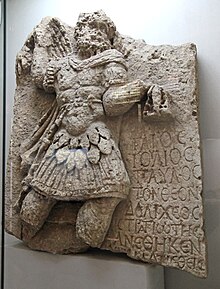Consecrative relief of Jupiter Dolichenus
A consecration relief of Jupiter Dolichenus was found in the ancient city of Perrhe in the area of Kommagene in southeastern Turkey . It is exhibited in the Adıyaman Archaeological Museum .
Find
The relief was found in the extensive necropolis of the city of Perrhe, now called Pirin, a district of the provincial capital Adıyaman . During excavation and cleaning work in 2001 by the Adıyaman Museum under the direction of its director Fehmi Erarslan, it was discovered as a cover for a late antique grave. Perrhe belonged to Samosata , Marasch and Doliche to the core cities of the empire Kommagene. This makes the relief of Jupiter Dolichenus the only one known so far that has been found in the direct area of origin of this god. While corresponding representations from the entire Roman Empire as far as Western Europe are numerous, they are rare in Asia Minor and Syria. The relief was discussed by Michael Blömer (relief) and Margherita Facella (inscription) as part of a project by the Asia Minor research center at the Westphalian Wilhelms University in Münster .
presentation
The stele made of yellow and white local limestone measures 0.81 meters in height and 0.63 meters in width. The base plate is 11 centimeters deep, the greatest height of the relief is 12 centimeters. It shows the god on the left and an eight-line inscription below the arm on the lower right. Large parts of the depiction are missing, the top of the headgear and both hands of the figure have broken off, only the thighs of the legs have survived, the break goes through the last line of the inscription. The relief protrudes strongly, parts of the figure such as the head and arms are almost fully plastic. In the posture typical of Jupiter Dolichenus, the god raised his right arm and bent the left. Only the lower part of the bundle of lightning in the left hand has survived; the usual double ax in the right hand is completely missing. He is shown with a beard and full head of hair. Both are shown in great detail with individual spiral curls. Despite the numerous bumps in the face, deep-set eyes with drilled pupils can be seen. The headgear is a Phrygian cap . The god is dressed in a military fashion. On his upper body he wears a Roman muscle armor over the tunic , which is held over the shoulders by flat leather strips, with a cingulum as a belt. Around the hips are the pteryges with deep, drilled furrows between them. Above the armor, the figure wears a paludamentum , which is held together on the right shoulder and, guided over the left, hangs down the back so that it is visible to the left behind the depicted person. A narrow balteus holds a sword on the right side of the body. The legs are dressed in trousers. The remains of an eagle are visible above the figure's right shoulder, behind the raised arm. Only the spread left wing and the tail feathers are preserved.
If you add the usual right-facing bull on which the god stands below, the representation corresponds to the well-known iconography of Jupiter Dolichenus. Noteworthy are the pants the god wears and the headgear. From the Roman point of view, both are oriental attributes that refer to the origin of the god. In other images from Northern Syria and Asia Minor, however, no trousers can be seen, as well as in the numerous images of the Syrian weather god, to whom the soldier god is attributed. Blömer concludes from this that these details were only added to the attributes of god later, according to Roman ideas.
inscription
In the lower right corner in the field between the left leg and left arm is the dedication . It is eight lines long, the letters are neatly engraved in the stone, but become smaller towards the bottom. The assumption is that the stonemason had problems to accommodate the given text in the free field. The inscription reads:
- Γάϊος ᾿Ιούλιος Παῦλος τὸν θὲον Δολίχεος στρατιώτης ἀνέθηκεν χ [ρ] ηματισθείς
- Gaius Iulius Paulus, soldier from Doliche, consecrated the god (his image) because he received an instruction.
This indicates the name of the consecrator, his profession and his origin as well as the reason for the dedication. The founder, who comes from Doliche, is στρατιώτης , i.e. soldier, and according to his name, a Roman citizen . Blömer and Facella assume that one of his ancestors was granted civil rights and took the gentile name Iulius . This noun , which is widespread in Northern Syria and also in the Kommagene, can mostly be traced back to the emperor who ruled at the time of the granting of citizenship, or to a governor of the province who was responsible for the granting. He does not specify which unit Gaius Julius Paulus belonged to. It is known that, towards the end of the 2nd century, soldiers of the Legio IIII Scythica were staying in Kommagene for construction work and that around the same time the Legio XVI Flavia company was commissioned with the construction of the Chabinas Bridge . But whether Paul came to Perrhe from one of these units or belonged to a vexillatio stationed in the area can only be speculated. The original location of the stele is also unclear.
The letter shapes are an indication of a chronological classification of the inscription in the period between the late 2nd and the beginning of the 3rd century.
literature
- Michael Blömer, Margherita Facella: A consecration relief for Iupiter Dolichenus from the necropolis of Perrhe. In: Engelbert Winter (ed.): ΠΑΤΡΙΣ ΠΑΝΤΡΟΦΟΣ ΚΟΜΜΑΓΗΝΗ. New finds and research between Taurus and Euphrates (= Asia Minor Studies. Volume 60). Dr. Rudolf Habelt GmbH, Bonn 2008, ISBN 978-3-7749-3517-4 , pp. 189-200.
